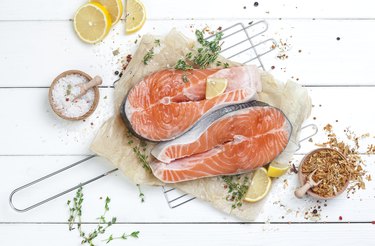
Gout sufferers need to avoid foods high in purines — naturally occurring compounds that your body metabolizes into uric acid. When your blood has too high a concentration of uric acid, it can accumulate in your joints, causing the swelling, inflammation and pain characteristic of gout.
While fish should be a part of a gout diet since they provide the omega-3 fatty acids that can help prevent heart disease and high blood cholesterol, certain types of fish may exacerbate gout symptoms. If you have questions about which seafoods are safe for a gout diet, talk to your doctor.
Video of the Day
Video of the Day
Fish to Avoid
Foods that contain 150 to 825 milligrams of purine compounds in every 100 grams are considered to be high-purine items and should be avoided by individuals on a gout diet. A number of fish fall into this category, including anchovies, mackerel, herring, sardines, cod, haddock and trout. Canned versions of these foods are also not allowed on a gout diet. Canned sardines have 480 milligrams of purines per 100 grams, and canned herring has 378 milligrams.
Fish to Include
Fish that don't fall into the high-purine category contain a moderate amount of purine compounds, with 50 to 150 milligrams of purines in every 100 grams. Examples include salmon, canned light tuna, flounder, sole and catfish.
People following a gout diet can include these fish in their diet, but only in moderation. One to two total servings of high-protein foods like moderate-protein fish, shellfish, poultry, lean meat, beans and legumes per day is recommended for gout patients, with a single serving of fish being equivalent to 2 to 3 cooked ounces.
Preparation Tips
It's important for a person adhering to a gout diet to keep his intake of high-fat foods as low as possible. Excess fat can stimulate your kidneys to retain uric acid, possibly leading to a flare-up of gout symptoms.
Instead of breading and deep-frying fish, try grilling, roasting or poaching fresh fillets with a minimum of added monounsaturated or polyunsaturated fats like olive or canola oil. To keep your sodium intake low, season fish with herbs, spices or fresh-squeezed lime or lemon juice instead of salt or high-sodium seasoning mixes.
Expert Insight
The Natural Resources Defense Council recommends choosing low-mercury fish when you eat seafood, especially if you are a pregnant or nursing woman or one who is trying to become pregnant. Avoid ahi tuna, swordfish, orange roughy and marlin, all of which are likely to have high levels of mercury contamination.
Fish like canned albacore tuna, bluefish, snapper and halibut can be eaten occasionally — between three to six times per month — but low-mercury, moderate-purine varieties such as flounder, tilapia, salmon and whitefish are the best choices.
- Kaiser Permanente: Purine-Restricted Diet: After Your Visit
- North East Medical Services: Low Purine Diet: Gout Prevention
- Litholink Corporation: Low-Purine Diet
- Natural Resources Defense Council: Consumer Guide to Mercury in Fish
- PubMed: Intake of purine-rich foods, protein, and dairy products and relationship to serum levels of uric acid